Classes and Instructors
CNCH to offer 16 diverse classes taught by experts in their fields
Sixteen of North America’s most widely respected fiber artists will teach a diversity of classes when the Conference of Northern California Handweavers meets in San Luis Obispo from Aug. 3 – 6, 2023. These instructors possess many decades of experience and will teach classes ranging from weaving and spinning, to dyeing, felting, tapestry, kumihimo, basketry and Sprang.
WEAVING
All weaving workshops require knowledge of how to wind a warp and independently warp a loom, plus at least beginning weaving ability on either a table or floor loom. (Please see instructor’s notes, where provided.) Students must come to class with warped looms and be prepared to begin weaving.
Inge Dam: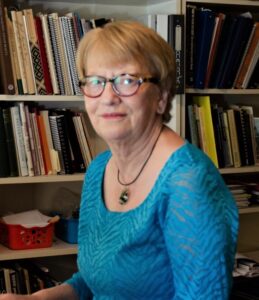 Tablet Band Incorporated Into Fabric: Make a Unique Fabric For a Small Bag – In this workshop, the participants will learn how to add a tablet band into a piece of fabric. A simple tablet weaving technique, the threaded-in technique, will be taught. A tablet warp will be made, and the participants will be taught how to arrange the tablet warp within the fabric warp that has been wound on the loom ahead of time. Participants will learn how two warps can be woven together using only one shuttle and how to avoid tension problems between the two warps.
Tablet Band Incorporated Into Fabric: Make a Unique Fabric For a Small Bag – In this workshop, the participants will learn how to add a tablet band into a piece of fabric. A simple tablet weaving technique, the threaded-in technique, will be taught. A tablet warp will be made, and the participants will be taught how to arrange the tablet warp within the fabric warp that has been wound on the loom ahead of time. Participants will learn how two warps can be woven together using only one shuttle and how to avoid tension problems between the two warps. 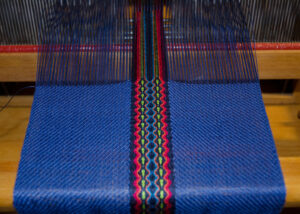 Additionally, participants will learn how to accommodate the difference in take-up of the two weaves. A small piece of fabric will be woven, and some ideas on how to sew the fabric into a bag, how to decorate it, and how to finish it off with a closure and a handle will be discussed.
Additionally, participants will learn how to accommodate the difference in take-up of the two weaves. A small piece of fabric will be woven, and some ideas on how to sew the fabric into a bag, how to decorate it, and how to finish it off with a closure and a handle will be discussed.
Skill Level: Advanced beginner. (Participants should know how to weave plain weave and 4-shaft straight twill.)
Materials fee: None. Handouts will be sent via email
Participants should bring:
Equipment: 4-shaft Loom with a weaving width of at least 15 inches: the wider the loom the more space you have to turn the tablets.
Tablets: 34
Reed: 8 or 10 dent reed.
Shuttles: 1 boat shuttle and 1 stick shuttle
4 large (2-liter) plastic bottles with caps (ginger ale or coke bottles) — to be used as weights for the tablet warp
2 big C-clamps: to be used to clamp your table loom to the table (if floor loom, these are not needed)
2 medium size C-clamps (2-3 inches): will be used to make the tablet warp around;
Yarn: 10/2 mercerized cotton in 4 colors (dark, medium, light). One of the colors is for the fabric warp and weft and also for the tablet warp, the other 3 colors are for the tablet warp as well (4 colors in tablet warp). You will need approx. 1/2 lb. for the fabric warp and weft, and 1/4 lb. of each color for the tablet warp. They should be coordinating colors with high contrast.
Other materials needed:
Graph paper (8-10 squares per inch)
paper, pencil, colored pencils, and eraser
ruler
measuring tape
scissors
scrap yarn for header (soft synthetic is good)
large rubber bands (short thick rubber bands do not work
reed hook.
Instructions on How to Set Up the Loom:
For this workshop there will be two warps on the loom. One of the warps will be the fabric warp and the other will be the tablet warp. The fabric warps will be in two sections (3 inches wide each) and the tablet warp will be approximately 1 inch wide. Participants should come to class with the fabric warp already wound on the loom and threaded. DO NOT SLEY IT. The tablet warp will be made in class and put on the loom in class.
How to make the fabric warp and put it on the loom:
Length of warp: Sett:
Reed size: Sley:
Total ends:
2 yards
24 ends per inch
8 or 10 dent
for 8-dent reed, 3 ends per dent; for 10-dent reed, 2,3,2,3 etc. (it becomes 25 epi instead)
144
Make the warp in two sections, 72 ends each. Place the fabric warp in the loom so that the two sections are separated by a 1-inch space. The space is for the tablet warp, because the tablet warp will be in the middle of the fabric. Thread the loom in a straight draw (1,2,3,4,repeat); when you have threaded the first section continue with the second section (4,3,2,1, repeat). Have a floating selvedge on both sides of the outer edges of the warp. Leave the warp there, it will be sleyed and tied to the front beam in class.
About the instructor: In 1992, Inge became a Master Weaver from Ontario Handweavers and Spinners (Canada). Her in-depth study was on Iron Age Textiles from Northern Europe. Through her study, she became interested in tablet weaving because several pieces of textiles with tablet woven borders have been found in Northern Europe dated to the Iron Age. From the knowledge she gained through her study, and with several years of experimenting with combining tablet weaving with loom weaving, she published a book in 2013, Tablet-Woven Accents for Designer Fabrics: Contemporary Uses for Ancient Technique. She has taught workshops in the US, Canada, England, and Japan. She has won many awards for her work, and her work has appeared in several publications. She weaves on a 40-shaft dobby loom.
Joanne Hall : Swedish Art Weaves – The very beautiful decorative weaves from southern Sweden are cherished by weavers all over Scandinavia, and they are a part of both historical and contemporary weaving in Sweden. In the past, the art weaves were used to weave table runners, long wall hangings (several yards long) hung up on special occasions, carriage cushions and pillows. Today they can be used for a variety of projects. They are mostly laid-in weaves on a plain weave ground weave. The warp is threaded to plain weave so that a variety of patterns and techniques can be woven all in one sampler. These include krabba, halvkrabba, rolakan tapestry, dukagang and monksbelt. These techniques give you more freedom in your woven designs.
: Swedish Art Weaves – The very beautiful decorative weaves from southern Sweden are cherished by weavers all over Scandinavia, and they are a part of both historical and contemporary weaving in Sweden. In the past, the art weaves were used to weave table runners, long wall hangings (several yards long) hung up on special occasions, carriage cushions and pillows. Today they can be used for a variety of projects. They are mostly laid-in weaves on a plain weave ground weave. The warp is threaded to plain weave so that a variety of patterns and techniques can be woven all in one sampler. These include krabba, halvkrabba, rolakan tapestry, dukagang and monksbelt. These techniques give you more freedom in your woven designs.
Skill Level: Some experience with equipment (in addition to a loom), able to warp a loom and thread plain weave; able to perform basic weaving techniques.
Materials fee: $50
Items included in Materials Fee: Warp, postage, weft, pick-up stick, half heddle sticks, misc. supplies for use in the workshop. Note: Instructor will send a wound linen warp to each participant with warping instructions. At the workshop I provide the weft and all supplies needed for weaving the sampler. I also lend small equipment for use in the workshop.
Equipment and Supplies Students Should Bring:
Warped four-shaft loom
Scissors
Tape measure
Two flat stick shuttles
Felt-tipped marker
Optional: colored pencils, a few pages of graph paper (any size), a slender boat shuttle or a couple extra stick shuttles. A hand-held mirror is helpful.
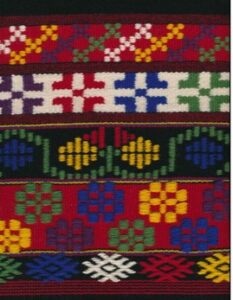
About the instructor: Joanne Hall has written several books including Learning to Warp Your Loom, Tying Up the Countermarch Loom, Mexican Tapestry Weaving, and Drawloom Weaving, An Introduction to Warping and Weaving on a Drawloom. In addition to teaching classes and workshops, Joanne has operated a business of importing yarns and weaving equipment from Sweden.
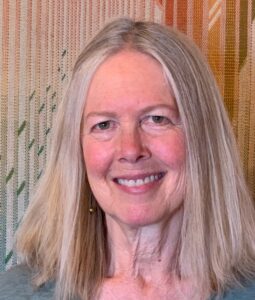 Jennifer Moore: Double Rainbow – This is perhaps the ultimate color sampler! You will begin by winding a warp and setting up your loom according to Jennifer’s system for working with multiple colors in a rotational sequence and bringing it to the workshop. A basic two-layered structure will enable you to mix and match our colors, creating an amazing array of color mixtures. As you weave and your warp colors move past each other, you will experience a visual feast of iridescence and
Jennifer Moore: Double Rainbow – This is perhaps the ultimate color sampler! You will begin by winding a warp and setting up your loom according to Jennifer’s system for working with multiple colors in a rotational sequence and bringing it to the workshop. A basic two-layered structure will enable you to mix and match our colors, creating an amazing array of color mixtures. As you weave and your warp colors move past each other, you will experience a visual feast of iridescence and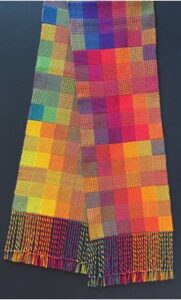 moire patterns. We will also experiment with single-layered structures such as warp rep and warp-faced twills and the effects that they create on this versatile warp. Those set up for two blocks on eight shafts will also be able to explore an unlimited range of block combinations. The workshop includes a comprehensive lecture on block doubleweave that will give you the tools to create your own block designs in doubleweave for as many shafts as you have. This sampler will provide a remarkable education in color theory and how optical mixtures work in weaving, as well as a great source of inspiration for future weaving projects.
moire patterns. We will also experiment with single-layered structures such as warp rep and warp-faced twills and the effects that they create on this versatile warp. Those set up for two blocks on eight shafts will also be able to explore an unlimited range of block combinations. The workshop includes a comprehensive lecture on block doubleweave that will give you the tools to create your own block designs in doubleweave for as many shafts as you have. This sampler will provide a remarkable education in color theory and how optical mixtures work in weaving, as well as a great source of inspiration for future weaving projects.
Skill Level: Intermediate, Students should be able to wind a warp and warp their looms according to instructions. No prior experience in double weave is necessary.
Materials Fee: $10
Items Included in Materials Fee: Class notebook and miscellaneous materials Equipment and Supplies Students Should Bring:
4-shaft or 8-shaft table or floor loom with 10″ or wider weaving width
2 boat shuttles
6 bobbins
Colored pencils or markets
a stack of sticky notes
perle cotton in either 5/2 or 10/2 weight, about 15 ounces total divided between 6 colors (Kits for this workshop are available through Lunatic Fringe and other yarn dealers)
Students will bring a loom that is pre-warped according to instructions that will be sent out
About the instructor: Jennifer Moore holds an MFA in Fibers specializing in mathematical patterns and musical structures in doubleweave wall hangings. Jennifer lives in Santa Fe, New Mexico and travels extensively to teach workshops in doubleweave, color and geometric design. She is the author of The Weaver’s Studio: Doubleweave, several doubleweave videos, and numerous articles.
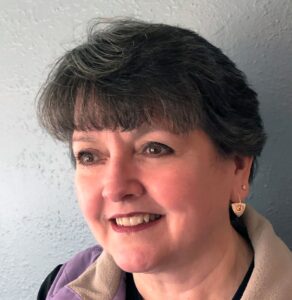 Robyn Spady: A Parallel Threading is a Weaver’s Playground – A parallel threading can provide a weaver with a multitude of options and patterns — from echo weaves and corkscrew twills to turned taquete and network-drafted twills. Add on top of that weft variations in color and texture, and a weaver will find her/himself in a playground of possibilities. Workshop participants will pre-warp their looms from a selection of threadings, and during the workshop they will enter into a journey of discovery and exploration of how to transform a parallel threading into a myriad of patterns. The workshop is a combination of presentation/discussion, weaving, and hands-on exercises. Emphasis will be on understanding the design and drafting processes to empower workshop participants to create their own patterns.
Robyn Spady: A Parallel Threading is a Weaver’s Playground – A parallel threading can provide a weaver with a multitude of options and patterns — from echo weaves and corkscrew twills to turned taquete and network-drafted twills. Add on top of that weft variations in color and texture, and a weaver will find her/himself in a playground of possibilities. Workshop participants will pre-warp their looms from a selection of threadings, and during the workshop they will enter into a journey of discovery and exploration of how to transform a parallel threading into a myriad of patterns. The workshop is a combination of presentation/discussion, weaving, and hands-on exercises. Emphasis will be on understanding the design and drafting processes to empower workshop participants to create their own patterns.
Skill Level: Adventure-seeking beginner through advanced waver. Four-shafts minimum. Eight shafts recommended. This is NOT a round-robin workshop.
Materials Fee: $15
Items included in Materials Fee: Workshop notebook, printed in color and spiral- bound; other supplies (e.g., yarn, etc.)
Equipment and Supplies Students Should Bring:
Pre-warped loom.
Student supply list: Warp loom per instruction (provided 6-8 weeks prior to the workshop), two shuttles, wefts, scissors, etc.

About the instructor: Robyn Spady has been weaving for over 50 years. She completed HGA’s Certificate of Excellence (COE) in 2004 with the specialized study Loom-controlled Stitched Double Cloth. Robyn is fascinated by the infinite possibilities of crossing threads, and she loves coming up with new ideas to create fabric and transform it into something new and exciting. Robyn is also the founder and editor of Heddlecraft magazine.
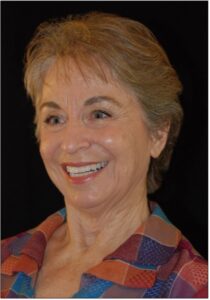 Jannie Taylor: A Survey of Loom-Controlled Lace – Learn about the types of loom-controlled lace weaves through illustrated lecture, guided practice, and hands-on weaving. Discover the subtle differences between the various lace weaves, how to tell them apart and why one may be more appropriate than another for a given project or a particular loom. Learn to use lace weaves to create beautiful and unusual textiles.
Jannie Taylor: A Survey of Loom-Controlled Lace – Learn about the types of loom-controlled lace weaves through illustrated lecture, guided practice, and hands-on weaving. Discover the subtle differences between the various lace weaves, how to tell them apart and why one may be more appropriate than another for a given project or a particular loom. Learn to use lace weaves to create beautiful and unusual textiles.
Students will each bring a loom, pre-threaded to a design provided by the instructor. Each workshop participant will leave the class with their own annotated Lace Weave workbook and a set of samples. Students will be able to weave an assortment of samples on looms threaded to a variety of lace weaves.
Skill Level: Beginner to advanced – should be able to read a weaving draft and thread a loom.
Materials Fee: $35 Optional additional fee: $15
Items included in Materials fee: Comprehensive, full-color workbook. Optional additional fee covers a collection of all workshop drafts plus bonus drafts in .wif format (can only be used with weaving software)
Equipment and Supplies Students Should Bring:
Loom, pre-threaded to a design provided by the instructor.
About the instructor: Jannie Taylor has been a handweaver and designer for more than 40 years. She teaches advanced 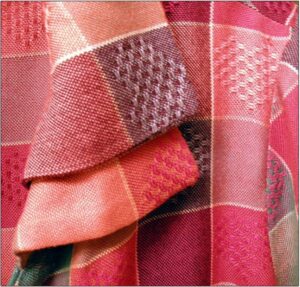 weaving classes at the AVL Weaving School and has offered classes at every Convergence since 2008. An inspired teacher, she enjoys sharing her knowledge and enthusiasm with other weavers in a relaxed, collaborative environment.
weaving classes at the AVL Weaving School and has offered classes at every Convergence since 2008. An inspired teacher, she enjoys sharing her knowledge and enthusiasm with other weavers in a relaxed, collaborative environment.
When she is not teaching, Jannie enjoys designing and weaving one-of-a-kind silk garments and scarves that show her fascination with the interplay of color, fiber, and structure within a woven work. Jannie has twice earned the Handweavers Guild of America award for “Outstanding Creativity and Craftsmanship in Weaving,” and her work has appeared on the cover of Shuttle, Spindle & Dyepot and has been featured in Weaver’s, Handwoven and Heddlecraft, the online weaving magazine. In addition, she is the instructor in two videos on Shadow Weave produced by Long Threads Media.
SPINNING
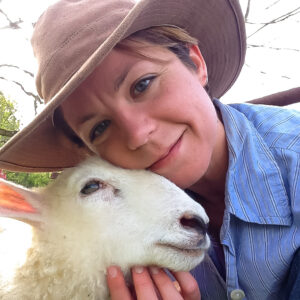 Kate Larson: Blending and Spinning for Color Effects – Modern spinners have a bounty of dyed locks, rovings, and combed tops at our fingertips. While much of what we buy is ready to spin, we also can dive in and make our own blends and adapted preparations. In this workshop, we will prepare and sample a variety of yarns — tweed, marled, ombre’, and more — while exploring color interactions and basic color theory. Learn to create several different preparations and blends using your handcards, and you’ll also have a chance to try your hand at color blending on a hackle.
Kate Larson: Blending and Spinning for Color Effects – Modern spinners have a bounty of dyed locks, rovings, and combed tops at our fingertips. While much of what we buy is ready to spin, we also can dive in and make our own blends and adapted preparations. In this workshop, we will prepare and sample a variety of yarns — tweed, marled, ombre’, and more — while exploring color interactions and basic color theory. Learn to create several different preparations and blends using your handcards, and you’ll also have a chance to try your hand at color blending on a hackle.
Skill Level: Ability to spin and ply a basic yarn.
Materials Fee: $40
Items Included in Materials Fee: Wide variety of dyed locks, rovings, and combed tops; handouts; record-keeping materials.
Equipment and Supplies Students Should Bring:
A spindle or working wheel, extra bobbins, lazy kate, and handcards. (Spindlers: bring a lazy kate or gear for your preferred plying method)
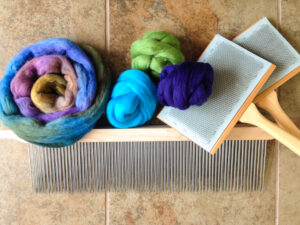
About the instructor: Kate Larson, editor of Spin Off and PieceWork magazines, loves using fiber arts as a bridge between her passions for art and agriculture. She keeps a flock of Border Leicester sheep and teaches handspinning and knitting throughout the United States. Kate is author of The Practical Spinner’s Guide: Wool (Interweave, 2015) and several videos, including How to Spin Yarn to Knit (Interweave, 2016). Follow her woolly adventures at KateLarsonTextiles.com
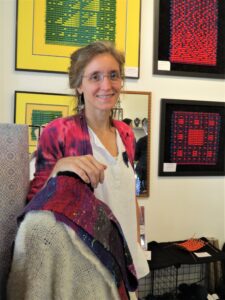 Angela Schneider: The Short and Long of Spinning – Explore drafting techniques and fiber preparations that cover the range from the smoothest worsted to the loftiest woolen yarns. One extreme creates firm, hard-wearing yarns with crisp definition, and the other maximizes softness and warmth (and it feels like magic to spin) . We’ll spin them both with a few steps in between, plus try the carding and combing techniques to go with them. We’ll examine the appropriate fibers, preparations, and characteristics for each.
Angela Schneider: The Short and Long of Spinning – Explore drafting techniques and fiber preparations that cover the range from the smoothest worsted to the loftiest woolen yarns. One extreme creates firm, hard-wearing yarns with crisp definition, and the other maximizes softness and warmth (and it feels like magic to spin) . We’ll spin them both with a few steps in between, plus try the carding and combing techniques to go with them. We’ll examine the appropriate fibers, preparations, and characteristics for each.
Skill Level: Must be able to spin a continuous yarn.
Materials Fee: $25
Items included in Materials Fee: spinning fiber
Equipment and Supplies Students Should Bring:
Single-drive spinning wheel (Scotch or Irish tension is fine, single or double treadle, or e-spinner is fine)
Lazy kate
Niddy noddy
Sewing gauge or small ruler
Recommended: hand cards, wool combs
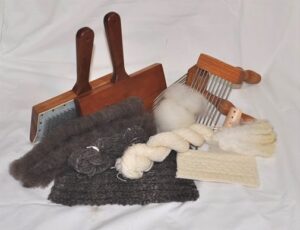
About the instructor: Angela Schneider is a weaver, spinner, knitter, and enthusiast for all textile structures from the common to the esoteric. She has degrees in engineering, math, and art, and a Master Spinner certificate from Olds College, Alberta. Angela worked in the tech industry as a programmer, network engineer, and trainer, and is project editor for Long Thread Media. Angela used math and language as design inspiration and explores improvisation in weaving. She teaches multiple fiber arts and is known as a patient and encouraging teacher. Angela is also a swing and contra dancer, instructor, and contra dance caller.
DYEING
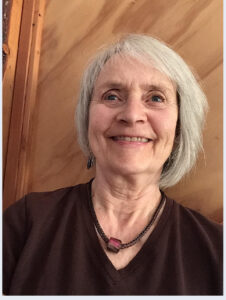 Nancy Finn: Working Your Way Around the Color Wheel: A Color Survey – Each student will create her/his own set of colors including primary, secondary, and tertiary colors. This also will include toned and shaded colors, as well as tints and a gray scale. Each student will create approximately 100 color samples, time and energy permitting. Skill Level: No skill level required (just a desire to learn how to avoid mud when mixing colors.)
Nancy Finn: Working Your Way Around the Color Wheel: A Color Survey – Each student will create her/his own set of colors including primary, secondary, and tertiary colors. This also will include toned and shaded colors, as well as tints and a gray scale. Each student will create approximately 100 color samples, time and energy permitting. Skill Level: No skill level required (just a desire to learn how to avoid mud when mixing colors.)
Materials fee: $30
Items included in Materials fee: All dyes, chemicals, sample fabric (10 mm habitai silk), 2 oz. spinning fiber and 1 skein of yarn for practice, all the cups, etc. for sample making, binder rings.
Equipment and Supplies Students Should Bring:
a pair of rubber gloves
a set of measuring spoons including 1/8, 1/4, 1/2, 1 teaspoon and 1 tablespoon
1-2 pint liquid measuring cups (plastic is OK)
a 1-hole punch
WEAR OLD CLOTHES or bring an apron
Notebook or note paper
FIBER and/or YARN from you stash. This is for day 2. Bring more than enough rather than too little. Make sure it is scoured (washed: Soak in hot water and Dawn.
SQUEEZE or SPIN OUT WATER. DO NOT RINSE!
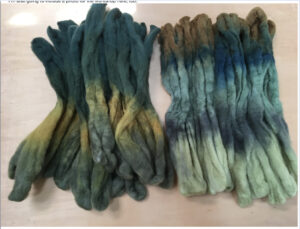
About the instructor: Nancy learned to knit when she was 7, was smitten with textiles and materials during her school years, and received a BA in textiles. She took weaving classes after graduation and continued learning all she could. She eventually knew she had to create her own colors for projects, which led her to dyeing – and a 30-year business devoted to dyeing and spinning fiber and yarn (Chasing Rainbows) and later, teaching workshops.
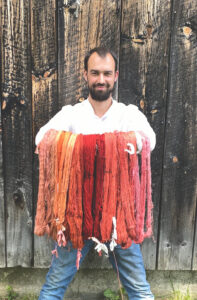
Graham Keegan: Know Madder: Many Roads, Many Reds – Red! Maroon! Plum! Peach! Flame Orange! Pink! Madder’s allure is its versatility, potency and longevity. Come explore the processes that allow the transfer of color from the roots of this hearty (and easy to grow) perennial onto a range of fibers. We will explore means of direct dyeing, dyeing with mordants, color shifting using pH and mordant after-baths to achieve a range of color tones. Madder is equally effective on fibers from plants as it is from animals, so we will be working with cotton, linen, wool and silk yarns. You will leave this class with a deeper understanding of the plant, how to grow and process it, how to harvest and store it and, of course, how to dye with it. This is a survey of madder’s potential, so we’ll be creating many small skeins of many different colors. We will not be bulk dyeing any single color or fiber type. Concepts will be explained from the ground up (pun intended).
Skill Level: No experience necessary: all levels.
Materials Fee: $45
Items included in Materials Fee: Dyes – whole root madder and madder extract, tannins, acids, bases, mordants, color sample yarns.
Equipment and Supplies Students Should Bring:
at least 20 small (approximately 10 g.) sample skeins of various fiber types that you like to weave with, so you can dye and have samples of your preferred materials. Additionally, I will be bringing skeins of a variety of materials to demonstrate with. Swatch samples will be cut from these and distributed to students as well.
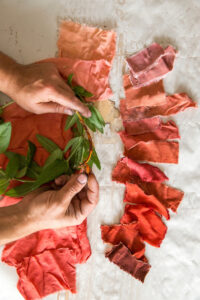
About the instructor: Graham Keegan is a dyer. He works exclusively with plant, animal and mineral pigments, growing and foraging a bulk of all his coloring material. His primary dye practice is print design using traditional methods such as rice paste resist stencil print, and mordant block printing onto cotton yardage. Over the past few years, time spent at the Marshfield School of Weaving in Vermont has steered his interest toward supporting weavers through teaching yarn dyeing on all natural fiber types.
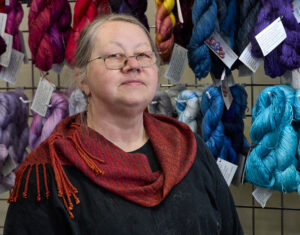
Teresa Ruch: Designing and Painting Warps – The goal is to look at various ways to design painted warps to give your design a unique look. We will start by dyeing a 2-scarf warp in a random fluid manner where one color flows into the next, creating shades, tints and tones and feather look one gets with most ikats. We will discuss why knowing the studio and fibers are important and how to adjust for successful end products. Some color theory, color formulas and studio practices will also be discussed. I will show you several different types of layout and design techniques that can be used in painted warps: how to plan them, dye them, and carry through for the effect you want to produce. Skill Level: No experience needed; all levels.
Materials Fee: $90
Items included in Materials Fee: One prepared soaked Tencel warp (2 scarf lengths), dyes, gloves, plastic wrap, microwaves and handouts. Additional materials (yarns) may be purchased in class.
Equipment and Supplies Students Should Bring:
Dye clothes, note taking materials
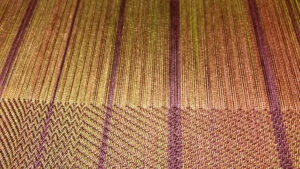
About the instructor: Teresa met her first loom at university and has been madly chasing it ever since. This has led her on an incredible journey. Teresa worked as a sample weaver and a CAD/CAM jacquard textile designer in industry before she opened Teresa Ruch Designs, her business that has been in production since 2009. Originally focused on weaving, yarn has become a larger part of her business in the last 10 years. Her company maintains an emphasis on color and hand in both the yarn and weaving. She has a passion for color, and this shows in her work: She likes color on color, pattern on color and the subtle sheen of fibers like Tencel/lyocel. The thought of using fibers from plants that grow in poor soil conditions, give back to the soil they come from, and do not use much water in the processing of the fiber is an added benefit. She is actively seeking out new methods and materials to dye that will benefit our environment.
BASKETRY
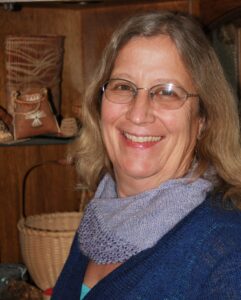 Deb Curtis: Birch Bark Exploration – From cylinders to stitched pieces of bark, the student will explore how birch bark can be made into vessels. We’ll start by making a cylinder that we stitch together, adding a footer and rim and base to make it a useful container. Next the student will design a vessel using cut pieces of birch bark stitched together. This is a class where you are given ideas/designs or you can design your own vessels.
Deb Curtis: Birch Bark Exploration – From cylinders to stitched pieces of bark, the student will explore how birch bark can be made into vessels. We’ll start by making a cylinder that we stitch together, adding a footer and rim and base to make it a useful container. Next the student will design a vessel using cut pieces of birch bark stitched together. This is a class where you are given ideas/designs or you can design your own vessels.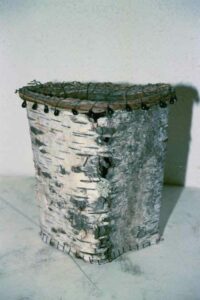
Skill level: All levels, beginning through advanced.
Materials fee: $130
Items included in Materials fee: Birch bark, cedar bark and birch bark, palm inflorescences, glovers needle, waxed linen, instruction sheets.
Equipment student needs to provide:
Scissors, basket basic tools, large-eyed needle (crewel needle size),bucket, if have it a jerry’s striper if not you can use instructor’s, if knitting or crocheting then 2 pairs size 6-10 knitting needles (can be circular or straight) or size b-J crochet hook old towel, craft scissors
wooden clothespins, any beads/feathers/etc. you would like to use for embellishment
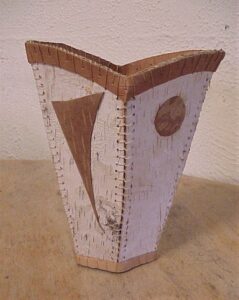
About the instructor: Deb Curtis is a basketry artist. After learning to weave an Appalachian Egg Basket while living in Virginia in 1982, Deb has continued to make baskets. She almost exclusively uses natural materials that she gathers or grows. For her, basketry is a tradition that is changing. She designs and produces contemporary baskets using traditional basketry materials.
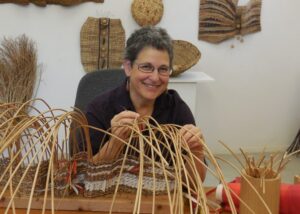 Polly Jacobs Giacchina: The Enhanced Twined Form – Discover other fiber techniques to embellish your initial twined form. Using multiple soft and hard materials, develop the surface of your work with these techniques: twining, knotless netting, random weave, stitching and applique.
Polly Jacobs Giacchina: The Enhanced Twined Form – Discover other fiber techniques to embellish your initial twined form. Using multiple soft and hard materials, develop the surface of your work with these techniques: twining, knotless netting, random weave, stitching and applique. 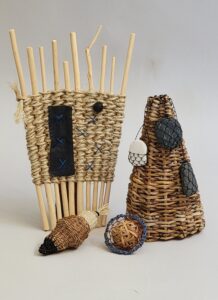
Skill level: All levels.
Materials Fee: $25
Items included in Materials Fee: Reed, caning, wire, date palm, waxed linen, and hemp; soaking tubs. Tools available to share.
Equipment and Supplies Students Should Bring:
Scissors
Large eye tapestry needle
Small needle-nose pliers
Small wire cutters
About the instructor: Polly Jacobs Giacchina started weaving with Joan Austun at San Diego State University. She went on to create a career in fiber arts. Polly has taught nationally and internationally at schools, conferences and workshops. She continues to show in juried exhibitions and galleries.
FELTING
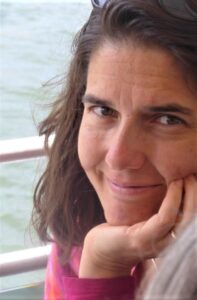 Flora Carlile-Kovacs: Felt Your Dreams: Prefelt with Nomadic Designs – In Kyrgystan, when a daughter got married, her mother felted her a rug. Using their ancient symbols, she felted her best wishes and good luck into the rug that stayed with her daughter for the rest of her life. In this workshop, you’ll create two complimentary pillow pads with the pre-felt technique, using either the several-hundred-year-old symbols or by creating your very own. Learn about the traditional symbols and techniques of the rugs; how to plan a powerful design; how to turn the soft prefelt into a strong and durable pillow pad; some tricks of the trade that make the felting process easier. As people of nomadic tribes in Kyrgyzstan felt their dreams and wishes in rugs, hoping they’ll come true, we’ll use the instructor’s pre-felt inlay technique to make our own pillows holding our own dreams.
Flora Carlile-Kovacs: Felt Your Dreams: Prefelt with Nomadic Designs – In Kyrgystan, when a daughter got married, her mother felted her a rug. Using their ancient symbols, she felted her best wishes and good luck into the rug that stayed with her daughter for the rest of her life. In this workshop, you’ll create two complimentary pillow pads with the pre-felt technique, using either the several-hundred-year-old symbols or by creating your very own. Learn about the traditional symbols and techniques of the rugs; how to plan a powerful design; how to turn the soft prefelt into a strong and durable pillow pad; some tricks of the trade that make the felting process easier. As people of nomadic tribes in Kyrgyzstan felt their dreams and wishes in rugs, hoping they’ll come true, we’ll use the instructor’s pre-felt inlay technique to make our own pillows holding our own dreams.
Skill level: All levels, beginner through advanced.
Materials fee: $30
Items included in Materials fee: Variety of natural and dyed batts especially suitable for the project (Mountain sheep, New Zealand merino, Mongolian, Karakul, Gottland)
Supplies/equipment student needs to provide:
notebook, pen/pencil for notes, camera, -2 hand towels, sprinkler if you have one, to wet the felt, 1 quart container for water, 1 olive oil soap bar in a container (or coconut oil or goatmilk soap or soap of your choice), very sharp and pointy scissors (embroidery scissors, box of pointy pins, 3×6′ bubble wrap (small bubbles), can be taped from smaller pieces 3×3′ cotton sheet or old cloth, 1 pool noodle 3′ long or a bath towel, 3′ long ruler or stick
optional: decorative yarn for embellishment (single ply, nice colors wool or mohair knitting yarn)
(waterproof) apron if needed, comfortable shoes
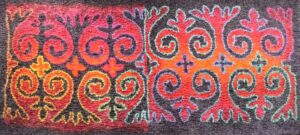
About the instructor: I was born and raised in Hungary. My interest in textiles drew me to graduate studies in ethnography and museology, but I had always felt a deeper passion for creating with fiber than analyzing it. I have experience creating many types of fiber arts, including embroidery, knitting, weaving, sewing, lace making, and basket weaving. One day in 2004, I discovered a felting class by accident, and was immediately drawn in. I was soon experimenting with the vast possibilities of making art with raw wool fiber, not returning to the other fiber arts but transforming all my previous fiber experiences into felt making. Over the past 16 years, I have improved my traditional techniques and invented new ones of my own. I enjoy making both wearable art and art for the wall, as well as teaching my craft on all levels.
KUMIHIMO
 Shirley Berlin: Japanese Braiding: Make Friends with a Marudai – Making braids on a disc is a good introduction to Kumihimo, but those nick-to-nick movements don’t capture the magic of working on real (or even adapted)
Shirley Berlin: Japanese Braiding: Make Friends with a Marudai – Making braids on a disc is a good introduction to Kumihimo, but those nick-to-nick movements don’t capture the magic of working on real (or even adapted) 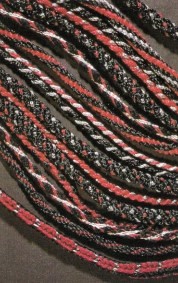 equipment. Using both hands to braid on a marudai is more efficient, and the new braider can quickly enjoy – and be bewitched by – the rhythm of the traditional Japanese movements. One pair of hand movements leads smoothly into the next (usually!), and the sound of many wooden bobbins moving in harmony is a memory for life. Skill level:Beginners welcome; braiders with experience will move ahead faster.
equipment. Using both hands to braid on a marudai is more efficient, and the new braider can quickly enjoy – and be bewitched by – the rhythm of the traditional Japanese movements. One pair of hand movements leads smoothly into the next (usually!), and the sound of many wooden bobbins moving in harmony is a memory for life. Skill level:Beginners welcome; braiders with experience will move ahead faster.
Materials fee: $25
Items included in Materials fee: Includes use of my yarns and beads; worksheets and booklet. $5 rental for marudai with bobbins, reimbursed if purchased.
Student Preparation requirements: None
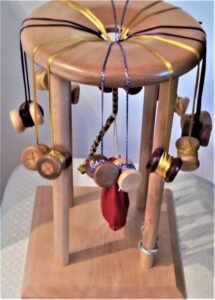
About the instructor: Shirley studied Kumihimo in England with Rodrick Owen and Makiko Tada in the 1980s and hasn’t finished learning about braiding yet. She teaches widely, including at the International Kumihimo Conferences in Japan. She co-edited 60 Sensational Samples, and her series of booklets about Kumihimo On A Card are widely used.
SPRANG
![]()
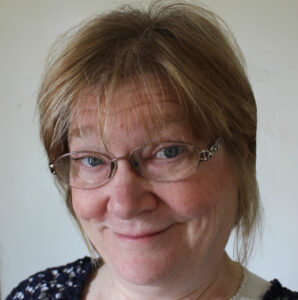 Carol James: Introduction to Sprang – Sprang is a textile technique that dates to ancient times. An adaptable technique for making stretchy cloth, it was all but forgotten with the Industrial Revolution. Learn the basic ‘stitch,’ and then see how it can be adapted and shaped, used to create bags, bonnets, socks, mittens, scarves, leggings, vests, and more. The primary goal of this workshop is to pique the interest of participants toward further exploration of the technique.
Carol James: Introduction to Sprang – Sprang is a textile technique that dates to ancient times. An adaptable technique for making stretchy cloth, it was all but forgotten with the Industrial Revolution. Learn the basic ‘stitch,’ and then see how it can be adapted and shaped, used to create bags, bonnets, socks, mittens, scarves, leggings, vests, and more. The primary goal of this workshop is to pique the interest of participants toward further exploration of the technique.
Skill level: No weaving experience necessary. Experienced loom-weavers will find this intriguing.
Materials fee: $50
Items Included in Materials Fee: Sprang frame (which students take home at the end of class); material for several warps, safety strings, shed sticks, rubber bands, and assorted other gizmos.
Equipment and Supplies Students Should Bring:
Glasses if you need them to read; two hands with fingers in good working order; colored pencils.
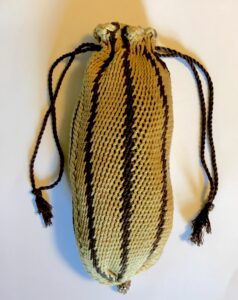
About the instructor: Carol James has explored low-tech textile methods for 30 years and is known for her skill in replicating historic textiles and creating modern garments. Carol has taught in Canada, the US, and Europe. Students describe her as patient, knowledgeable, and passionate. She has authored numerous articles, 3 books, and 2 instructional DVDs.
TAPESTRY
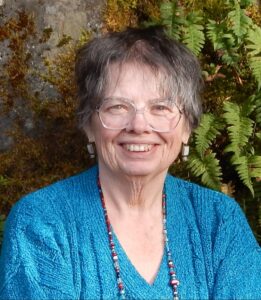 Kathe Todd-Hooker: Line and Detail and the Geometry of Tapestry – All about weaving and controlling lines, shapes, vertically, horizontally, diagonally and curves. Discussions of pull-in and pull-out and eccentric weaving. Applying techniques to squares, circles and triangles to get perfect shapes, toothless, smooth and step-less edges, and no squishing. Techniques used and explored: Soumack, splitting the weft, vertical understanding of the techniques that help tapestry weavers achieve the designs and shapes they really want.
Kathe Todd-Hooker: Line and Detail and the Geometry of Tapestry – All about weaving and controlling lines, shapes, vertically, horizontally, diagonally and curves. Discussions of pull-in and pull-out and eccentric weaving. Applying techniques to squares, circles and triangles to get perfect shapes, toothless, smooth and step-less edges, and no squishing. Techniques used and explored: Soumack, splitting the weft, vertical understanding of the techniques that help tapestry weavers achieve the designs and shapes they really want.
Skill level: More than beginner – must have woven a tapestry or basic sampler.
Materials Fee: $17/$30*
Items included in Materials fee: For $17, extensive handouts and any design papers needed for use in class. For $30, instructor will supply everything the student needs (with the exception of a loom); handouts warp and a weft.
Equipment and Supplies Students Should Bring:
Warped loom with tension (Instructor is more than willing to show up early or the night before to help warp looms); favourite weaving tools — nothing special because I bring tools for students to try; paper drawing supplies.
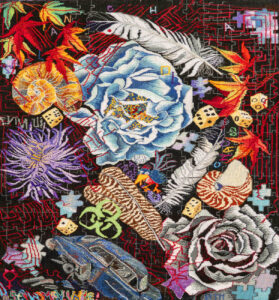
About the instructor: Kathe is an award-winning narrative tapestry weaver, designer, instructor of tapestry and related arts since 1981; writer, author, NW native, an ardent student of myth and symbolism that seeps into her imagery. She has studied Gobelin, Swedish, British, Coptic, Middle Eastern and kesa techniques – a tech nerd who synthesizes the techniques to solve technical and design problems in tapestry.